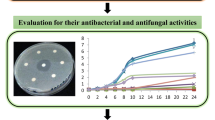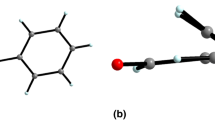Abstract
A series of imidazole and benzimidazole derivatives was designed and prepared in good yields via convenient and efficient two steps synthetic route using readily available starting materials. The structures of the synthesized compounds and their intermediates were characterized by IR, 1H-NMR, 13C-NMR spectroscopy, and MS spectra. The in vitro antifungal activities of the targeted compounds were evaluated against Candida Albicans, Cryptococcus neoformans, Aspergillus niger, and Microsporum gypseum. The results showed that some of these azole-derivatives exhibited good to excellent antifungal activities against the used strains especially C. neoformans and A. niger. For example, compound 6b, 1-[2-Phenyl-2-(3-phenyl-propoxy)-ethyl]-1H-imidazole, was quite effective on the C. neoformans, A. niger, and M. gypseum with MIC 1.95 µg mL−1. The in silico molecular docking study was also done on the synthesized compounds and the results showed they have minimum binding energy and relatively good affinity toward cytochrome P450. According to the in vitro antifungal results and molecular docking studies, the compounds 6a–d can be selected as lead compounds for further pharmaceutical investigations.





Similar content being viewed by others
References
Ascioglu S, Rex JH, Pauw BDe (2002) Defining opportunistic invasive fungal infections in immunocompromised patients with cancer and hematopoietic stem cell transplants: an International Consensus. Clin Infect Dis 34:7–14
Brown GD, Denning DW, Levitz SM (2012) Tackling human fungal infections. Science 336:647
Campoy S, Adrio JL (2017) Antifungals. Biochem Pharmacol 133:86–96
Chandrika NT, Shrestha SK, Ngo HX, Garneau-Tsodikova S (2016) Synthesis and investigation of novel benzimidazole derivatives as antifungal agents. Bioorg Med Chem 24:3680–3686
Chandrika NT, Shrestha SK, Ngo HX, Tsodikov OV, Howard KC, Garneau-Tsodikova S (2018) Alkylated piperazines and piperazine–azole hybrids as antifungal agents. J Med Chem 61:158–173
Fang XF, Li D, Tangadanchu VKR, Gopala L, Gao WW, Zhou CH (2017) Novel potentially antifungal hybrids of 5-flucytosine and fluconazole: design, synthesis and bioactive evaluation. Bioorg Med Chem Lett 27:4964–4969
Karimiyan A, Najafzadeh H, Ghorbanpour M, Hekmati-Moghaddam SH (2015) Antifungal effect of magnesium oxide and copper oxide nanoparticles against Candida albicans. Zahedan J Res Med Sci 17:25–27
Keller P, Müller C, Engelhardt I, Hiller E, Lemuth K, Eickhoff H, Wiesmüller, KH, Burger-Kentischer A, Bracher F, Rupp S (2015) An antifungal benzimidazole derivative inhibits ergosterol biosynthesis and reveals novel sterols. Antimicrob Agents Chemother. https://doi.org/10.1128/AAC.00640-15
Khalafi-Nezhad A, Soltani Rad MN, Hakimelahi GH, Mokhtari B (2002) One step synthesis of imidazole and benzimidazole acycloaromatic nucleoside analogs. Tetrahedron 58:10341–10344
Khalafi-Nezhad A, Mokhtari B, Soltani Rad MN (2003) Direct preparation of primary amides from carboxylic acids and urea using imidazole under microwave irradiation. Tetrahedron Lett 44:7325–7328
Khalafi-Nezhad A, Mokhtari B (2004) Tetrabutylammonium bromide: an efficient media for dimethoxytritylation of the 5′-hydroxyl function of nucleosides. Tetrahedron Lett 45:6737–6739
Meng X-Y, X Zhang H-, Mezei M, Cui M (2011) Molecular docking: a powerful approach for structure-based drug discovery. Curr Comput Aided Drug Des 7:146–157
Pfaller MA, Chaturvedi V, Espinel-Ingroff A, Ghannoum MA, Gosey LL, Odds FC, Rex GH, Rinaldi MG, Sheehan DG, Walsh TG, Warnock DW (2002) Reference method for broth dilution antifungal susceptibility testing of yeasts, approval standard, 2nd edn.Clinical and Laboratory Standards Institute, Wayne, Pennsylvania, USA, 19087–1898
Pfaller MA, Diekema DJ (2007) Epidemiology of invasive candidiasis: a persistent public health problem. Clin Microbiol Rev 20:133–163
Özel Güven Ö, Erdoğan T, Göker H, Yıldız S (2007) Synthesis and antimicrobial activity of some novel phenyl and benzimidazole substituted benzyl ethers. Bioorg Med Chem Lett 17:2233–2236
Revie NM, Iyer KR, Robbins N, Cowen LE (2018) Antifungal drug resistance: evolution, mechanisms and impact. Curr Opin Microbiol 45:70–76
Sheehan DJ, Hitchcock CA, Sibley CM (1999) Current and emerging azole antifungal agents. Clin Microbiol Rev. 12:40–79
Shrestha SK, Garzan A, Garneau-Tsodikova S (2017) Novel alkylated azoles as potent antifungals. Eur J Med Chem 133:309–318
Shukla PK, Singh P, Yadav KR, Pandey S, Bhunia SS (2016) Past, Present, and Future of Antifungal Drug Development. In: Saxena AS, (ed) Communicable Diseases of the Develo** World. Springer, Berlin, pp 125–167
Yusuf E, Versporten A, Goossens H (2017) Is there any difference in quality of prescribing between antibacterials and antifungals? Results from the first global point prevalence study (Global PPS) of antimicrobial consumption and resistance from 53 countries. J Antimicrob Chemother 72:2906–2909
Zhao D, Zhao S, Zhao L, Zhang X, Wei P, Liu C, Hao CB, Sun C, Su X, Cheng M (2017) Discovery of biphenyl imidazole derivatives as potent antifungal agents: design, synthesis, and structure–activity relationship studies. Bioorg Med Chem 25:750–758
Zhao S, Wei P, Wu M, Zhang X, Zhao L, Jiang X, Hao C, Su X, Zhao D, Cheng M (2018) Design, synthesis and evaluation of benzoheterocycle analogues as potent antifungal agents targeting CYP51. Bioorg Med Chem 26:3242–3253
Zirngibl L (1998) Antifungal Azoles: A Comprehensive Survey of their Structures and Properties. Wiley‐VCH, Weinheim
Acknowledgements
The authors gratefully acknowledge financial support from the Shahid Chamran University of Ahvaz.
Author information
Authors and Affiliations
Corresponding author
Ethics declarations
Conflict of interest
The authors declare that they have no conflict of interest.
Ethical approval
This article does not contain any studies with human participants or animals performed by any of the authors.
Additional information
Publisher’s note: Springer Nature remains neutral with regard to jurisdictional claims in published maps and institutional affiliations.
Rights and permissions
About this article
Cite this article
Shojaei, P., Mokhtari, B. & Ghorbanpoor, M. Synthesis, in vitro antifungal evaluation and docking studies of novel derivatives of imidazoles and benzimidazoles. Med Chem Res 28, 1359–1367 (2019). https://doi.org/10.1007/s00044-019-02369-7
Received:
Accepted:
Published:
Issue Date:
DOI: https://doi.org/10.1007/s00044-019-02369-7




